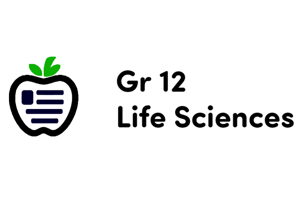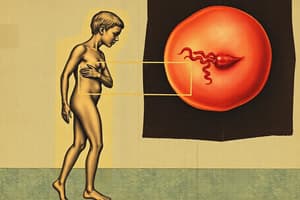Podcast
Questions and Answers
What is the immediate result of fertilization?
What is the immediate result of fertilization?
- An embryo with 23 chromosomes.
- A fully formed fetus ready for implantation.
- A group of specialized cells.
- A zygote with 46 chromosomes. (correct)
Which process contributes to genetic variation during fertilization?
Which process contributes to genetic variation during fertilization?
- The combination of genetically different sperm and ova. (correct)
- The equal division of chromosomes during mitosis.
- The exact replication of parental chromosomes in the zygote.
- The random mutation of genes during gamete fusion.
Where does the embryo typically implant after fertilization?
Where does the embryo typically implant after fertilization?
- Lining of the uterus (correct)
- Fallopian tube
- Ovary
- Amniotic sac
What is the main role of the amniotic fluid?
What is the main role of the amniotic fluid?
What is the function of the amnion?
What is the function of the amnion?
Which sequence accurately describes the developmental order after fertilization?
Which sequence accurately describes the developmental order after fertilization?
How many chromosomes are present in human sperm and ova?
How many chromosomes are present in human sperm and ova?
By what process does a zygote divide?
By what process does a zygote divide?
What is restored through the fusion of gametes during fertilization?
What is restored through the fusion of gametes during fertilization?
What is the primary function of fertilization?
What is the primary function of fertilization?
Which event is critical for fertilization to occur?
Which event is critical for fertilization to occur?
After fertilization, the zygote undergoes rapid cell division and differentiation. What is the name given to the ball of cells formed?
After fertilization, the zygote undergoes rapid cell division and differentiation. What is the name given to the ball of cells formed?
What is the significance of sperm and ova being 'genetically different'?
What is the significance of sperm and ova being 'genetically different'?
What process forms the sperm and ova?
What process forms the sperm and ova?
The embryo develops a placenta once implanted in the uterus. What is its function?
The embryo develops a placenta once implanted in the uterus. What is its function?
A scientist is studying a cell with 46 chromosomes. Which of the following is MOST likely true about this cell?
A scientist is studying a cell with 46 chromosomes. Which of the following is MOST likely true about this cell?
Certain toxins can cross the placental barrier and affect the developing embryo. Which of the following structures provides a cushioning protection against physical impacts, but NOT against these toxins?
Certain toxins can cross the placental barrier and affect the developing embryo. Which of the following structures provides a cushioning protection against physical impacts, but NOT against these toxins?
A researcher is investigating potential causes of early miscarriages. If they are focusing on the role of the amnion, which aspect of its function would be MOST relevant to their study?
A researcher is investigating potential causes of early miscarriages. If they are focusing on the role of the amnion, which aspect of its function would be MOST relevant to their study?
In a genetics experiment, a researcher discovers that a sperm cell has 24 chromosomes instead of the normal 23. If this sperm fertilizes a normal ovum, how many chromosomes will the resulting zygote have?
In a genetics experiment, a researcher discovers that a sperm cell has 24 chromosomes instead of the normal 23. If this sperm fertilizes a normal ovum, how many chromosomes will the resulting zygote have?
What types of cells do the embryo specialize to become?
What types of cells do the embryo specialize to become?
Flashcards
What is Fertilisation?
What is Fertilisation?
The process where the sperm nucleus fuses with the ovum nucleus.
What is a Gamete?
What is a Gamete?
Male or female reproductive cell that has only half the number of chromosomes (23 in humans).
What does Haploid mean?
What does Haploid mean?
Having a single set of unpaired chromosomes.
What does Diploid mean?
What does Diploid mean?
Signup and view all the flashcards
What is a Zygote?
What is a Zygote?
Signup and view all the flashcards
What is an Embryo?
What is an Embryo?
Signup and view all the flashcards
What is Mitosis?
What is Mitosis?
Signup and view all the flashcards
What is the Amnion?
What is the Amnion?
Signup and view all the flashcards
What is Amniotic Fluid?
What is Amniotic Fluid?
Signup and view all the flashcards
Study Notes
Fertilisation
- When a sperm reaches the ovum, its nucleus enters the ovum and fuses with the ovum's nucleus.
- Gametes have half the chromosomes, so the zygote created by fertilisation will have the full number.
- Fertilisation is the merging of haploid male and female gametes. This restores the diploid number of chromosomes.
- Human sperm and ova contain 23 chromosomes each.
- The resulting zygote has 46 chromosomes, like other body cells.
- Fertilisation offers another way to create genetic differences.
- Sperm and ova are genetically unique due to meiosis.
- Fertilisation combines different combinations of alleles.
The Zygote
- Every zygote must divide to create cells to form the adult.
- All cells must have the full chromosome number, so the zygote divides by mitosis.
- An embryo is formed, and cells specialise into bone, nerve, and muscle cells.
- The embryo will implant in the uterus lining and grow a placenta.
The Amniotic Sac and Amniotic Fluid
- During a pregnancy, the amnion membrane encloses the embryo.
- The amnion secretes amniotic fluid which protects the embryo from bumps with cushioning.
Studying That Suits You
Use AI to generate personalized quizzes and flashcards to suit your learning preferences.




